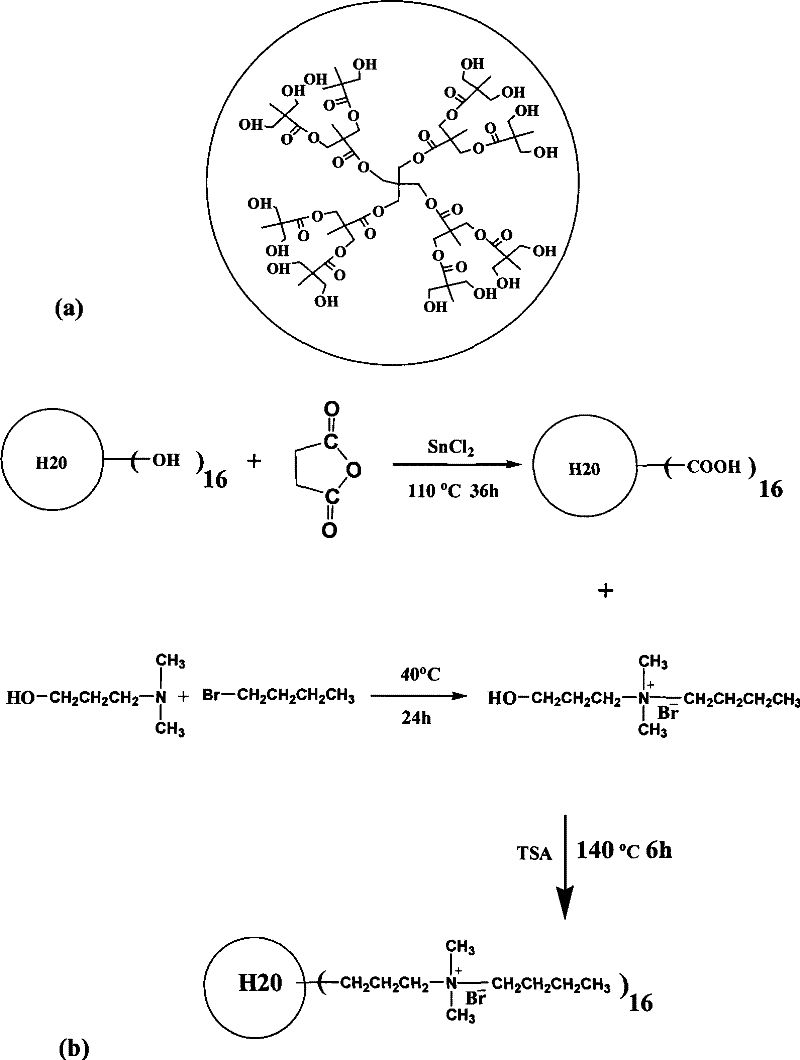Fabrication method of polymer resistive humidity sensor with hyperbranched structure
A technology of a humidity sensitive element and a manufacturing method, applied in the direction of material resistance, etc., can solve the problems of difficulty in measuring low-humidity environment, difficulty in measuring high resistance, difficulty in ion migration, etc., and achieve the advantages of cheap raw materials, improved contact, and improved ionic conductivity. Effect
- Summary
- Abstract
- Description
- Claims
- Application Information
AI Technical Summary
Problems solved by technology
Method used
Image
Examples
Embodiment 1
[0031] 1) cleaning the surface photolithography and evaporating the ceramic substrate with interdigitated gold electrodes, and drying for later use;
[0032] 2) In the 100 ml three-necked flask after dehydration and deoxygenation treatment, add 10 grams of hyperbranched compound H O with structure (I), 10 grams of succinic anhydride, 0.2 grams of SnCl 2 , 30 ml of dioxane, argon for 30 minutes, then heated up to 120 ° C, stirred and reacted for 36 hours under the protection of argon to obtain a transparent viscous liquid, named H2O-COOH.
[0033] 3) Add 20 grams of 3-dimethylamino-1-propanol, 30 grams of n-bromobutane, and 80 milliliters of acetone to the 250 milliliter three-necked flask after dehydration and deoxygenation treatment, stir well, and pass argon for 30 Minutes, then heated to 40°C, stirred and reacted for 36 hours under argon protection, a large amount of white precipitate was obtained, vacuum filtered, washed several times with acetone, vacuum dried overnight a...
Embodiment 2
[0037] 1) cleaning the surface photolithography and evaporating the ceramic substrate with interdigitated gold electrodes, and drying for later use;
[0038] 2) In the 100 ml three-necked flask after dehydration and deoxygenation treatment, add 12 grams of hyperbranched compound H O with structure (I), 12 grams of succinic anhydride, 0.24 grams of SnCl 2 , 30 ml of dioxane, argon for 30 minutes, then heated up to 120 ° C, stirred and reacted for 36 hours under the protection of argon to obtain a transparent viscous liquid, named H2O-COOH.
[0039] 3) Add 26 grams of 3-dimethylamino-1-propanol, 34 grams of n-bromobutane, and 80 milliliters of acetone in the 250 milliliter three-neck flask after dehydration and deoxygenation treatment, stir well, and pass argon gas for 30 Minutes, then heated to 40°C, stirred and reacted for 36 hours under argon protection, a large amount of white precipitate was obtained, vacuum filtered, washed several times with acetone, vacuum dried overnigh...
Embodiment 3
[0043] 1) cleaning the surface photolithography and evaporating the ceramic substrate with interdigitated gold electrodes, and drying for later use;
[0044] 2) In the 100 ml three-necked flask after dehydration and deoxygenation treatment, add 20 grams of hyperbranched compound H O with structure (I), 20 grams of succinic anhydride, 0.4 grams of SnCl 2 , 60 ml of dioxane, argon for 30 minutes, then heated up to 120 ° C, stirred and reacted for 48 hours under the protection of argon to obtain a transparent viscous liquid, named H2O-COOH.
[0045] 3) Add 30 grams of 3-dimethylamino-1-propanol, 40 grams of n-bromobutane, and 100 milliliters of acetone to the 250 milliliter three-neck flask after dehydration and deoxygenation treatment, stir well, and pass argon for 30 Minutes, then raised the temperature to 60°C, stirred and reacted for 36 hours under the protection of argon, and obtained a large amount of white precipitate, which was vacuum filtered, washed several times with a...
PUM
| Property | Measurement | Unit |
|---|---|---|
| width | aaaaa | aaaaa |
| interdigital gap | aaaaa | aaaaa |
Abstract
Description
Claims
Application Information
 Login to View More
Login to View More - R&D
- Intellectual Property
- Life Sciences
- Materials
- Tech Scout
- Unparalleled Data Quality
- Higher Quality Content
- 60% Fewer Hallucinations
Browse by: Latest US Patents, China's latest patents, Technical Efficacy Thesaurus, Application Domain, Technology Topic, Popular Technical Reports.
© 2025 PatSnap. All rights reserved.Legal|Privacy policy|Modern Slavery Act Transparency Statement|Sitemap|About US| Contact US: help@patsnap.com



